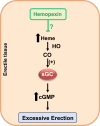Targeting heme in sickle cell disease: new perspectives on priapism treatment
- PMID: 39086934
- PMCID: PMC11288928
- DOI: 10.3389/fphys.2024.1435220
Targeting heme in sickle cell disease: new perspectives on priapism treatment
Abstract
Men with sickle cell disease (SCD) frequently experience priapism, defined as prolonged, painful erections occurring without sexual arousal or desire. This urological emergency can lead to penile fibrosis and permanent erectile dysfunction if not treated adequately. Due to its complex pathophysiology, there is currently no effective preventative treatment for this condition. Recent studies have highlighted the dysfunction of the nitric oxide (NO) and cyclic guanosine monophosphate (cGMP) pathway in erectile tissues as a critical mechanism in developing priapism in SCD. Additionally, further research indicates that intravascular hemolysis promotes increased smooth muscle relaxation in the corpus cavernosum and that excess heme may significantly contribute to priapism in SCD. Pharmacological treatments should ideally target the pathophysiological basis of the disease. Agents that reduce excess free heme in the plasma have emerged as potential therapeutic candidates. This review explores the molecular mechanisms underlying the excess of heme in SCD and its contribution to developing priapism. We discuss pharmacological approaches targeting the excess free heme in the plasma, highlighting it as a potential therapeutic target for future interventions in managing priapism.
Keywords: corpus cavernosum; haptoglobin; heme; heme oxygenase; hemopexin.
Copyright © 2024 Silveira, Calmasini, de Oliveira, Costa and Silva.
Conflict of interest statement
The authors declare that the research was conducted in the absence of any commercial or financial relationships that could be construed as a potential conflict of interest.
Figures
Similar articles
-
Soluble guanylate cyclase stimulators and activators: new horizons in the treatment of priapism associated with sickle cell disease.Front Pharmacol. 2024 Feb 7;15:1357176. doi: 10.3389/fphar.2024.1357176. eCollection 2024. Front Pharmacol. 2024. PMID: 38384294 Free PMC article. Review.
-
Nitric Oxide Resistance in Priapism Associated with Sickle Cell Disease: Mechanisms, Therapeutic Challenges, and Future Directions.J Pharmacol Exp Ther. 2024 Jul 18;390(2):203-212. doi: 10.1124/jpet.123.001962. J Pharmacol Exp Ther. 2024. PMID: 38262744 Review.
-
Heme-induced corpus cavernosum relaxation and its implications for priapism in sickle cell disease: a mechanistic insight.Andrology. 2024 Nov;12(8):1857-1864. doi: 10.1111/andr.13599. Epub 2024 Jan 17. Andrology. 2024. PMID: 38231174
-
Intravascular hemolysis leads to exaggerated corpus cavernosum relaxation: Implication for priapism in sickle cell disease.FASEB J. 2022 Oct;36(10):e22535. doi: 10.1096/fj.202200867R. FASEB J. 2022. PMID: 36070139
-
Hydroxyurea does not reverse functional alterations of the nitric oxide-cGMP pathway associated with priapism phenotype in corpus cavernosum from sickle cell mouse.PLoS One. 2023 Oct 9;18(10):e0292706. doi: 10.1371/journal.pone.0292706. eCollection 2023. PLoS One. 2023. PMID: 37812620 Free PMC article.
Cited by
-
Editorial Comment: Targeting Heme in Sickle Cell disease: New Perspectives on Priapism Treatment.Int Braz J Urol. 2025 Jan-Feb;51(1):e20249926. doi: 10.1590/S1677-5538.IBJU.2024.9926. Int Braz J Urol. 2025. PMID: 39556855 Free PMC article. No abstract available.
-
A retrospective research of adverse event reporting system events for voxelotor based on the FAERS database.BMC Pharmacol Toxicol. 2025 Apr 3;26(1):74. doi: 10.1186/s40360-025-00915-1. BMC Pharmacol Toxicol. 2025. PMID: 40181444 Free PMC article.
References
-
- Alvaia M. A., Maia H. A. A. da S., Nelli A. de M., Guimarães C. O. S., Carvalho E. S. de S., Netto J. M. B., et al. (2020). Prevalence of priapism in individuals with sickle cell disease and implications on male sexual function. Einstein (Sao Paulo) 18, eAO5070. 10.31744/einstein_journal/2020AO5070 - DOI - PMC - PubMed
Publication types
LinkOut - more resources
Full Text Sources


